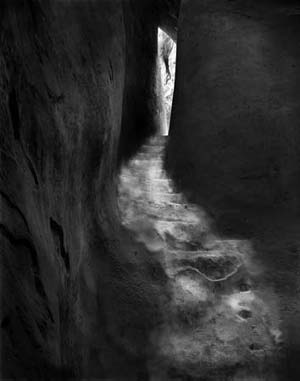
|
Into The Light
 Imagine you're a cartoon artist. The character you're drawing has a question on his mind. You draw his furrowed brow. Small drops of perspiration start to leap
from his forehead depicting his mental gymnastics as he wrestles with the question. Suddenly the answer pops into his head. How do you draw this? You draw a lightbulb
going on in his head.
Imagine you're a cartoon artist. The character you're drawing has a question on his mind. You draw his furrowed brow. Small drops of perspiration start to leap
from his forehead depicting his mental gymnastics as he wrestles with the question. Suddenly the answer pops into his head. How do you draw this? You draw a lightbulb
going on in his head.A question is like darkness. An answer is like a revealing light. The answer "dawns" on you. All the world sees knowledge as light. And the lack of knowledge as darkness. There's a famous Jewish joke that goes: "Why do Jews always answer one question with another?" "Do they?" Jews have always asked questions. Mark Twain spoke of the Jew's "aggressive and inquisitive mind." The basic linguistic structure of the Talmud is shakla v'tarya, the "give-and�take" of question and answer. More than any other festival, Pesach is a time of questions and answers. If there's one image that symbolizes the Passover Seder meal, it is the youngest child summoning up all of his or her courage and asking, "Ma Nishtana? Why is this night different from all other nights?" - the Four Questions. Look in the Haggada - the universal Jewish text which tells the story of the Exodus - however, and you'll find many more than just four questions: "The wise son, what does he say? 'What are the testimonies, decrees, and ordinances which Hashem, our god, has commanded you?' The wicked son, what does he say? 'of what purpose is this work to you?' The simple son, what does he say? 'What is this?'... Rabbi Yosei the galilean said: 'How does one derive that the Egyptians were struck...with fifty plagues at the sea?'... Matza - why do we eat this unleavened bread?... Maror - why do we eat this bitter herb?... Who knows one? Who knows two? Three? Four?..." Asking and answering is the essence of the Seder. In fact, even two Torah scholars making the Seder together are nonetheless obliged to ask each other these same questions. More, a lone Torah scholar would ask and answer those questions to himself. It must be, then, that the methodology of question-and-answer reveals something essential about the Passover experience. "And there was evening, and there was morning, one day" (Bereishit 1:5). The Torah teaches us that night preceded day. First came evening and only then morning. What is the message of this process? Why should night precede day? This is a world that starts in deficiency, in night. In this world, perfection can come only after imperfection. Morning can come only after evening. Light can come only after dark. In the existence beyond this world, perfection can exist without a preceding imperfection. That is a world of truth. A world of light. A world of total revelation. But in this world we can approach perfection only by a journey from the imperfect. Absence leads to presence. Emptiness becomes filled. Night becomes day. When a person emerges from a darkened room, he squints and hides his eyes from the sunlight. His perception of the light is a function of his perception of the darkness. When we begin at the bottom, the top seems higher when we get there. In a sense, when we start at the bottom the top is higher, for in our struggle, we have endowed the summit with all the elevation of our climb. True elevation only comes with a climb from a low place. The lowest place in the world three thousand years ago was Egypt. Egypt was the epitome of impurity; morally, the most poisonous place in the world. The mystics talk of forty-nine gates of spiritual corruption. The Jews in Egypt had reached that forty-ninth gate, the spiritual nadir. The word for impurity - tuma - connotes constriction, being sealed off. The opposite of tuma is tahara. Tahara comes from the same root as the word for "light" and "shining." When we talk of the Exodus as being a journey from darkness into light, this is not mere poetic sentiment. The Exodus was an escape from a literal darkness of the soul into the light. The essence of the Passover story is a journey from slavery into freedom, from darkness into light. As the Haggada says, "originally our ancestors were idol worshipers, but now the omnipresent has brought us near to Him." The Seder is designed for us to experience the Exodus to the maximum degree. our aim is to feel as though we ourselves were actually leaving Egypt. The great Sages who formulated the Haggada wanted us to experience that journey from darkness into light not just in the content of the words of the Haggada, but in its very form and style. They constructed the Haggada as a paradigm for the Exodus itself. Slavery to freedom. Darkness into light. Question into answer. The lightbulb goes on. THE HIDDEN LIGHT
Your Light is hidden here
in double-dreaming folds sown in the heart of the loving and the loved they wait to see You between the twisting of un-consequence, Fate to Fate. More articles available at Ohr Somayach's website. |